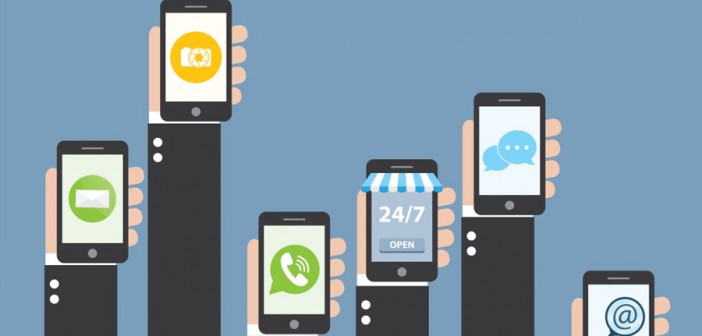The growth of both mobile device usage and advertising over these devices has exploded over the last couple of years, as we have all heard daily. The average United States adult spends nearly three hours a day on his or her mobile device, with advertising-friendly mediums such as games (78 percent), social networking (65 percent) and retail (46 percent) as favorites among mobile content choices.
Advertisers will spend $100 billion worldwide in 2016, so clearly everyone is jumping on the mobile advertising train and doing it right. Right? Well, not exactly.
There are several industries that could really elevate themselves still by using mobile because of the dedicated consumer audience built in to their verticals.
These four industries – music, gas stations, grocery/consumer packaged goods and movie theaters – are primed for mobile disruption. Here is why brands and advertisers should be paying attention.
Gas stations. According to the NACS, more than 300 people visit a gas pump per day that is attached to some type of convenience/retail store, and about 35 percent – approximately 105 – of those customers go inside to make a purchase.
Even if each consumer buys a $1 pack of gum, the retailer could bring in as much as $40,000 extra each year. But what if you could get your consumers to spend more?
Enter mobile. If you walk into a gas station today, you will see while most consumers are pulling in or waiting to finish pumping their gas, they are always on their phone checking daily activities during their break from driving.
Using technologies such as geofencing and beacons in mobile advertising allows you to capture that moment at the pump to drive consumers into the store via a marketing message or rich media experience.
Maybe it is a coupon for two-for-one hot dogs or for discounted drinks. Either way, you can target these consumers who use their mobile phones and serve them tailored ads that will entice them to enter the store and make a purchase.
Grocery/consumer packaged goods. Our grandparents, and even our parents, had a simple shopping routine when it came to weekly groceries. They would get the weekly print circular out of the mail and then head off to their favorite store to get what they need.
But times have changed and so have our shopping habits. Print, radio and television barely make up half of our daily media consumption.
Besides consuming more content on mobile – think coupons – we are shopping at more grocery stores than generations before.
The days of family loyalty to one store do not really exist any more. Forty-five percent of grocery shoppers go to two or more stores to check off their lists, while 30 percent shop at four or more stores. The lesson?
Consumers are looking for best deals and they are looking for their mobile devices to guide them there.
So how can the grocery/CPG establishments capitalize?
An omnichannel mobile strategy gives the consumer the complete shopping experience she wants – product browsing, checkout, deals and specials, and delivery – from the palm of her hand. It also allows brands to reach their consumers through targeted ads that directly influence path to purchase, using technologies such as geofencing, mobile CRM and verified in-store walk in.
Movie theaters. In 2013, 1.34 billion movie tickets were sold in the U.S. and Canada – a massive, captivated audience open to your brand’s messaging.
Consumers go to the movies for one thing: to relax, unplug and stare straight ahead for two-plus hours of audio/visual stimulation. The likelihood of someone actively blocking out anything that is projected on the screen is effectively nil.
So how can brands take advantage of these large audiences who are already in the consumption mindset?
Considering most theatergoers enjoy the large format advertisements before the show, integrating a precision-targeted ad to complement this broadcast format would be wise.
Using mobile, brands can bring addressable ads into theaters so that the emotion created by the ads on the screen can be instantly acted upon once the patron leaves the theater.
A prime example?
A national restaurant such as TGIFridays runs one of its ads on the big screen before the show, advertising its late-night bar menu and drink specials.
Once the movie ends and patrons leave the theater, TGIFridays can retarget them with a mobile ad that not only continues the pre-show dialogue and brand building, but also achieves a business result by providing a 15 percent-off coupon to the theatergoer.
Music. The music industry can take advantage of location-based mobile marketing by understanding geo-patterns.
Music is something that everyone enjoys at certain times during the day, from driving in the car to working out in the gym. Some even enjoy listening to music while they work.
The music industry has the opportunity to advertise to music listeners when they are in the mindset of actually listening to music or discovering new music.
Music has become a mainstream for brands to connect with consumers.
For example, music festivals are sponsored by lifestyle brands. This year’s Lollapalooza was sponsored by Sprint.
All brands want to associate with the lifestyle of certain genres of music because it is easier to connect with those consumers.
An example: a Taylor Swift fan based, on location data and concert tours, might be a target for a CPG store that is promoting a sweepstakes for a meet-and-greet with Ms. Swift at her next concert.
The CPG store can use rich, mobile media to bring the consumer in-store to make a purchase as part of the contest, and then retarget them after the concert with another promotion as well.
AS MOBILE CONTINUES to innovate, brands will need to keep looking for creative avenues to allow their voice to be heard amongst all of the other white noise. Including these verticals into their mobile advertising strategy is a strong start.




